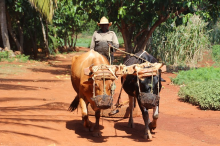 |
| Replacing machinery with oxen (Photo: CC0) |
This is the positive message of the latest report from the International Panel of Experts on Sustainable Food Systems (IPES-Food), launched this week in Rome. It presents seven case studies from different countries and continents which demonstrate that agroecological change is taking hold across the globe.
The group of leading food system experts, co-chaired by former UN Special Rapporteur on the right to food Olivier De Schutter and nutrition expert Olivia Yambi, says that successful transition to agroecology requires changes in four key dimensions – in production practices, in knowledge generation and dissemination, in social and economic relations, and in institutional frameworks. If change happens at these different levels, reliance on the existing brokers of inputs, knowledge, and market access is drastically reduced and the multiple ‘lock-ins’ of industrial food systems can be overcome and new sustainable food systems can start to emerge. “Transition really takes off when change happens on various fronts at the same time. That’s when new power relations start to form and the logic of the system starts to shift,” said Steve Gliessman, lead author of the report.
One case studies focuses in how Cuba managed to turn economic isolation after the collapse of the Soviet Union into an opportunity for agroecological transition. In response to the crisis, the small-scale agricultural sector in Cuba underwent an “agroecological revolution”. The peasantry was able to increase production despite a severe reduction in external inputs. Changes in production practices included input substitution followed by the adoption of techniques such as diversification, crop rotation, agroforestry and crop-livestock integration. Knowledge generation and dissemination were enabled by a burgeoning campesino-a-campesino movement aimed at farmer-to-farmer knowledge exchange. Institutional actors and research centres provided farmers with knowledge and a variety of seeds and biological inputs for free. Farmers and government agencies were able to deepen their scientific and professional competences via ‘bus tours’ to different farms. Peasant farmers also obtained lots of information through the cooperatives to which most of them belonged. Agroecology was institutionalized in the educational curricula of Cuba’s Agricultural Polytechnic Institutes.
IPES-Food says that changes in social and economic relations led to the rapid scaling of agroecology. A highly organized peasant agroecology movement driven by the national small farmers’ association made knowledge dissemination possible and built solidarity among farmers. Social relations have also evolved through and in response to land ownership modalities under the Socialist regime. Most Cuban farmers privately own their land but cultivate it as part of cooperatives which provide services, credit, and bulk input purchasing. Land, machinery and warehouses in these cooperatives are owned collectively. Changes in institutional frameworks include the decentralization of state farm sector, the institutionalization of agroecology in state and research institutions as well as supportive policies such as land reform. Today, some 300,000 small-scale farmers are said to be practicing agroecology in Cuba. Studies suggest that agroecological practices are applied on 46-72% of small-scale farms, accounting for about 60% of the vegetables, maize, beans, fruits, and pork consumed in Cuba. In addition, urban agriculture (virtually chemical free) has flourished, now supplying up to 70% of the consumption of fresh vegetables in larger cities, making Cuba a global leader in urban agriculture.
Another case study describes how an “Ecovillage” project in Chololo, Tanzania successfully used a package of agroecological practices, aimed at making the most of the limited rainfall, improving soil fertility, reducing farmers’ workload, and improving the quality of local seeds. The village in the semi-arid drylands of Central Tanzania faced challenges such as recurrent drought, food insecurity and vulnerability to climate change. A multidisciplinary project team encouraged villagers to take up and refine agroecological practices, from manure-based soil fertility improvements to water conservation features and optimal planting schedules. Technical guidance through technology groups and farmer-to-farmer outreach as well as a participatory approach to problems and solutions changed the way how knowledge was generated and disseminated. Social and economic relations changed due to community-building through awards, celebrations and the visibility of pioneering farmers. Part of the project was also to empower women to pursue new livelihood activities, such as chicken rearing.
Changes in institutional frameworks were achieved through the conscious alignment of the project with national climate adaptation policy. The inclusion of local institutions has allowed Chololo Ecovillage to become relevant to national-level policymaking and to emerge as a benchmark case for building climate resilience. Agroecological transition had an enormous impact on the lives of the people in Chololo. At the end of the first project cycle 2011-2014, 54% of farmers and livestock keepers used climate change adaptation innovations, an increase from just 19% during the first year, and yields increased between 37.5 to 70%. The percentage of households eating three meals per day increased from 29% to 62% and the average period of food shortage was reduced from 7.3 to 2.8 months. “The case studies show that change doesn’t always start in the field. Transition can be kick-started by community-building activities, farmer-researcher partnerships and even by external shocks that make people question the status quo,” said Steve Gliessman.









No comments:
Post a Comment